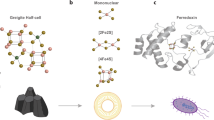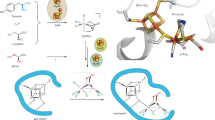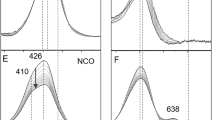Abstract
A ferredoxin isolated from Desulfovibrio africanus contains a [3Fe–4S] cluster that reversibly binds a copper atom, yielding a stable product with a greatly increased reduction potential. The reaction is readily detected in protein molecules adsorbed as a film on an electrode surface. Electron paramagnetic resonance (EPR) and magnetic circular dichroism (MCD) spectra of oxidized and reduced bulk solution products support their assignment as [Cu3Fe–4S]2+ (S=1/2) and [Cu3Fe–4S]1+ (S=2) respectively, with copper bound formally as Cu(l). Cyanide causes selective loss of copper and regeneration of the [3Fe–4S] reactant. The results demonstrate the chemical feasibility of CuFeS clusters and suggest that they could exist naturally in biological systems.
This is a preview of subscription content, access via your institution
Access options
Subscribe to this journal
Receive 12 print issues and online access
$189.00 per year
only $15.75 per issue
Buy this article
- Purchase on Springer Link
- Instant access to full article PDF
Prices may be subject to local taxes which are calculated during checkout
Similar content being viewed by others
References
da Silva, J.R.R.F. & Williams, R.J.P. The Biological Chemistry of the Elements: The Inorganic Chemistry of Life (Oxford University Press, 1991).
Kim, J. & Rees, D.C. Crystallographic structure and functional implications of the nitrogenase molybdenum-iron protein from Azotobacter vinelandii. Nature 360, 553–560 (1992).
Holm, R.H. Trinuclear cuboidal and heterometallic cubane-type iron-sulfur clusters: new structural and reactivity themes in chemistry and biology. Adv. Inorg. Chem. (eds Cammack, R. & Sykes, A.G.) 38, 1–71 (1992).
Surerus, K.K., Münck, E., Moura, I., Moura, J.J.G. & LeGall, J. Evidence for the formation of a ZnFe3S4 cluster in Desulfovibrio gigas ferredoxin II. J. Am. chem. Soc. 109, 3805–3806 (1987).
Butt, J.N. et al. Investigation of metal ion uptake reactivities of [3Fe-4S] clusters in proteins: voltammetry of co-adsorbed ferredoxin-aminocyclitol films at graphite electrodes and spectroscopic lidentification of transformed clusters. J. Am. chem. Soc. 113, 6663–6670 (1991).
Srivastava, K.K.P. et al. Mössbauer study of ZnFe3S4 and NiFe3S4 clusters in Pyrococcus furiosus ferredoxin. Inorg. Chem. 32, 927–936 (1993).
Li, Y.-J. & Weser, U. Circular dichroism, luminescence, and electronic absorption of copper binding sites in metallothionein and its chemically synthesised α and β Forms. Inorg. Chem. 31, 5526–5533 (1992).
Cotton, F.A. & Wilkinson, U. Advanced Inorganic Chemistry 5th edn. (1988).
George, S.J., Armstrong, F.A., Hatchikian, E.C. & Thomson, A.J. Electrochemical and spectroscopic characterisation of the conversion of the 7Fe into the 8Fe form of ferredoxin III from Desulfovibrio africanus. Biochem. J. 264, 274–287 (1989).
Butt, J.N. et al. Binding of thallium(I) to a [3Fe–4S] cluster: evidence for rapid and reversible formation of [TI3Fe–4S]2+ and [TI3Fe–4S]1+ centers in a ferredoxin. J. Am. chem. Soc. 113, 8948–8950 (1991).
Armstrong, F.A. Dynamic electrochemistry of iron-sulfur proteins. Adv. Inorg. Chem. (eds Cammack, R.; & Sykes, A.G.) 38, 117–163 (1992).
Armstrong, F.A., Butt, J.N. & Sucheta, A. Voltammetric studies of redox-active centers in metalloproteins adsorbed on electrodes. Meth. Enzym. 227, 479–500 (1993).
Butt, J.N. et al. Voltammetric characterisation of rapid and reversible binding of an exogenous thiolate ligand at a [4Fe–4S] cluster in ferredoxin III from Desulfovibrio africanus. J. Am. chem. Soc. 115, 1413–1421 (1993).
Shen, B. et al. Azotobacter vinelandii ferredoxin I. aspartate 15 facilitates proton transfer to the reduced [3Fe–-4S] cluster. J. biol. Chem. 268, 25928–25939 (1993).
Butt, J.N. et al. Voltammetric study of protongated electron transfer in a mutant ferredoxin: altering aspartate to asparagine blocks oxidation of the [3Fe–4S] cluster of Azotobacter vinelandii ferredoxin I. J. Am. chem. Soc. 115, 12587–12588 (1993).
Armstrong, F.A., Butt, J.N., George, S.J., Hatchikian, E.C. & Thomson, A.J. Evidence for reversible multiple redox transformations of [3Fe–4S] clusters. FEBS Lett. 259, 15–18 (1989).
Shen, B. et al. Azotobacter vinelandii ferredoxin I. alteration of individual surface charges and the [4Fe–4S]2+/+ reduction potential. J. biol. Chem. 269, 8564–8575 (1994).
Küppers, H.-J. et al. Crown thioether complexes of Ag(I) and Cu(I): the crystal structures of [{Ag3L3}{AgL2}](CIO4)4 and [LCu(I)] (L = Trithiacyclononane) Angew. Chem. Int. Ed. Engl. 26, 575–576 (1987).
Hatchikian, E.C. & Bruschi, M. Characterisation of a new type of ferredoxin from Desulfovibrio africanus. Biochim. biophys. Acta 631, 41–51 (1981).
Author information
Authors and Affiliations
Rights and permissions
About this article
Cite this article
Butt, J., Niles, J., Armstrong, F. et al. Formation and properties of a stable ‘high-potential’ copper-iron-sulphur cluster in a ferredoxin. Nat Struct Mol Biol 1, 427–433 (1994). https://doi.org/10.1038/nsb0794-427
Received:
Accepted:
Issue Date:
DOI: https://doi.org/10.1038/nsb0794-427
This article is cited by
-
Protein film electrochemistry
Nature Reviews Methods Primers (2023)
-
Heterometallic [AgFe3S4] ferredoxin variants: synthesis, characterization, and the first crystal structure of an engineered heterometallic iron–sulfur protein
JBIC Journal of Biological Inorganic Chemistry (2013)
-
Cells enforce an ion curtain
Nature (2008)



